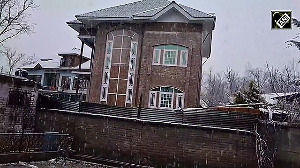Key scientists behind the Chandrayaan-1 mission are gathering in Bangalore on Thursday for the first time since the October 22 launch of India's maiden moon exploration to analyse preliminary data generated using payloads on board.
The day-long session at Indian Space Research Organisation Satellite Centre assumes significance in view of some encouraging findings thrown up after India's historic moon odyssey.
ISRO Chairman G Madhavan Nair told PTI that the agency has invited the scientists and expects representation from scientists behind Indian payloads (scientific instruments) as well those from guest instruments, including from NASA and the European Space Agency.
Chandrayaan-1 has 11 instruments on board -- five from India, three from ESA (one of which is developed jointly with India and other with Indian contribution), one from Bulgaria and two from the US.
An ISRO official said, "It will be a closed-door meeting. The scientists will analyse data from preliminary findings".
The session would be chaired by senior ISRO scientist George Joseph.
Preliminary findings from the data generated by three instruments on board Chandrayaan-1 -- the Moon Mineralogy Mapper (M3), Mini-SAR and the Imaging X-ray Spectrometer (CIXS) -- are encouraging.
M3, an imaging spectrometer from Brown University and Jet Propulsion Laboratory of the US through NASA, has taken a composite image of the Orientale Basin region of the moon, providing new information.
The image revealed changes in rock and mineral composition and abundance of iron-bearing minerals such as pyroxene and provided new detail on the form and structure of the lunar surface.
Images sent by Mini-SAR (Mini Synthetic Aperture Radar), from Johns Hopkins University's Applied Physics Laboratory and Naval Air Warfare Centre, USA, through NASA, showed the floors of permanently shadowed polar craters on the Moon that are not visible from the Earth.
Scientists are using the instrument to map and search the insides of the craters for "water ice".
CIXS, an ESA payload, jointly developed by Rutherford Appleton Laboratory of Britain and the ISRO Satellite Centre in Bangalore, has successfully detected the first X-ray signature from the Moon. This is the first step in its mission to reveal the origin and evolution of the moon by mapping its surface composition.
"I think it is quite good," Nair said of the preliminary findings, adding, "Most of things are on expected lines. The performance of the instruments was as planned. We hope to get a lot of scientific information out of that."
In addition, an ISRO official said preliminary findings from ISRO instruments such as Terrain Mapping Camera and Hyperspectral Imager, among others, are also expected to be shared at the conclave.






 © 2025
© 2025